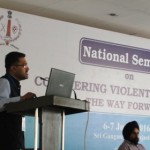A recent visit to Sri Ganganagar, the northern-most town of Rajasthan for the Sardar Patel Police University’s national seminar on ‘Countering Violent Extremism’ (CVE) served as a useful reminder in understanding the challenges faced by the law enforcement agencies – Rajasthan Police, Central Reserve Police Force and Border Security Force (BSF) – in the India-Pakistan border areas. The seminar, a first of its kind in India, focusing on the concept of the CVE and its relevance in the Indian context, was organised by the Police University’s Centre for Peace and Conflict Studies. It offered a good platform for the local security agencies to understand the concept of CVE, the tech-savviness of the terrorist group, Daesh and the role of social media in its dissemination. It gave them an occasion to reflect on their own role in containing its spread among the border communities.
Why Sri Ganganagar? Because the town’s location is strategic. It is situated on the India-Pakistan border and directly across it, approximately 200 km. away on the Pakistan side, is the town of Bahawalpur, headquarters of the Jaish-e-Mohammed- the terrorist group which carried out the attack on the Pathankot airbase in January 2016. Unlike the international border in Jammu and Kashmir, this area doesn’t see much cross-border hostility, but it is a hotbed of smuggling- drugs, fake currency and small arms. The BSF officials maintain that they have zero tolerance for such activities, but also admit that it is difficult to prevent every incident of smuggling, given the nature of the terrain and the smugglers’ constant success in inventing new ways to sneak in the contraband. These factors have made the task of guarding this particular border the most challenging as smuggling of contraband items is an important activity linked to terrorist financing.
There are other hurdles, as pointed out by the BSF officers. In Punjab and Rajasthan, across many border points, Pakistan has raised ditch-cum-bunds very close to the border. Standing close to the BSF post and fence, these bunds appear as hillocks. These have been raised so that the Indian Army’s tanks, if they cross the border during any potential conflict situations, are unable to advance further, which gives Pakistan a tactical advantage.
At the seminar, officials from the security agencies highlighted the critical role of community policing and engagement, in containing the spread of extremist propaganda and proliferation of nefarious activities among the border communities, as well as generating local intelligence. Police officers from other areas of Rajasthan brought examples of their own experience. For instance, a Superintendent of Police revealed that when he had implemented a community engagement initiative to better the lives of the sandstone workers in a district closer to the Rajasthan-Madhya Pradesh border, it had yielded useful intelligence about local criminals and a dacoits’ network of the Chambal area. The BSF too mentioned its attempts to increase outreach with the border communities through its civic action programmes. Both examples stressed on the need to primarily engage with the communities, in which the law enforcement agencies operate, as this can create mutual trust and help the police in establishing a local intelligence network.
The highlight of my visit was the opportunity to walk along the international border, not once, but twice in one and half days. Visiting the India-Pakistan border is always a fascinating experience, and a good opportunity to pick up new data points for research on infiltration, smuggling and terrorist financing.
The sweltering heat- 47 degrees of dry heat and loo (hot wind)- brought home the hardship faced by the constables of the BSF. Ordinarily a BSF constable has to spend 12 hours daily, in two shifts of six-hours each, at the border observation post. However, the extra workload means that sometimes these duties can stretch to 18 hours, leaving them with very little time for sleeping and recreation.
During the second visit in the same trip to another post, it was heartening to see women constables guarding the post at one of the watch towers. In 2009, the BSF had opened up the border deployment duties and combat tasks for women and begun deploying them on the India-Pakistan border.
Despite being part of the Thar Desert, Sri Ganganagar town and many parts of the district, have benefitted considerably by the Gang Canal, built in late 1920s by Maharaja Ganga Singh of Bikaner. The difference between Indian and Pakistani sides is stark. On the Indian side, the villagers had harvested multiple crops like Wheat, Cotton, Sugarcane and Kinnow fruit. Even at the peak of the summer heat, the area was lush and green, with water flowing through the canal. However, on the Pakistan side, the lack of water and irrigation facilities was apparent; there is an absence of any farming activity or even village life. A lone Pak Ranger post stands amidst a sparse cover of shrubs. Life is clearly better on the Indian side of the border.
Sameer Patil is Fellow, National Security, Ethnic Conflict and Terrorism, at Gateway House.
Click here to view our repository on the Arc of India’s Border Security.
This blog was exclusively written for Gateway House: Indian Council on Global Relations. You can read more exclusive blogs here.
For interview requests with the experts, or for permission to republish, please contact outreach@gatewayhouse.in or 022 22023371.
© Copyright 2016 Gateway House: Indian Council on Global Relations. All rights reserved. Any unauthorised copying or reproduction is strictly prohibited.


